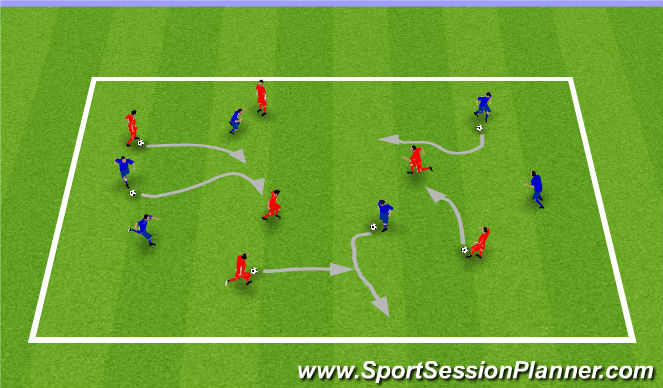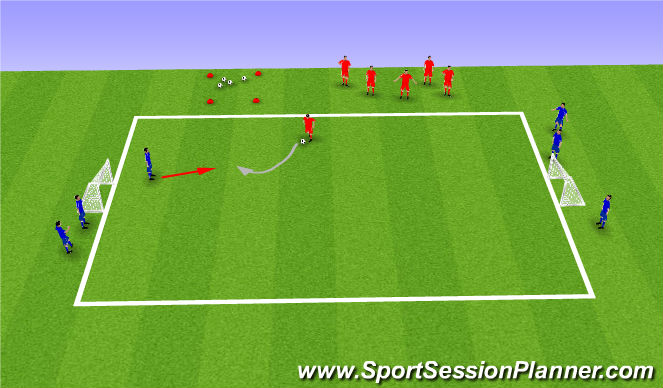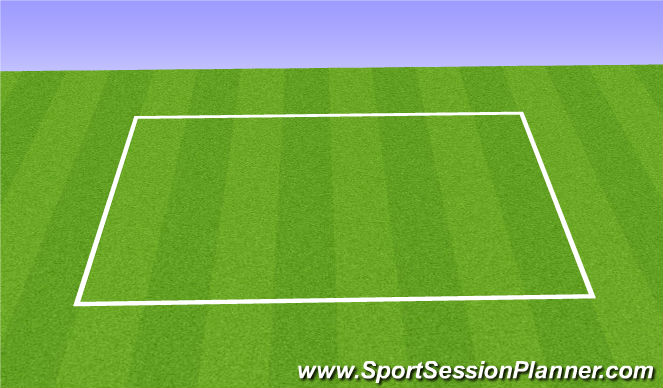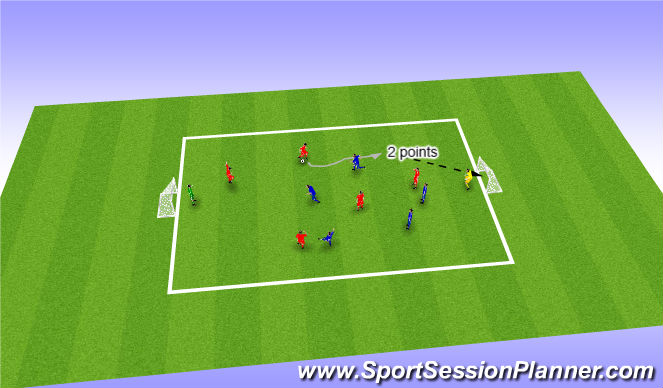Football/Soccer Session (Beginner): Dribbling and RWTB

Profile Summary

| Name: | Cameron Higgins |
|---|---|
| City: | Derby |
| Country: | United Kingdom |
| Membership: | Adult Member |
| Sport: | Football/Soccer |
Description
Session Topic: Dribbling and Running with the Ball.
Learning Objectives: - To be able to keep close control of the ball within tight spaces. - Be able to dribble past defenders at high speeds whilst under pressure, keeping the ball under control.
Player information: - 12 players - 5-11 years old - Mixed ability
Session length: 1 hour
Order of practices: Random (SSG), Blocked, Variable, Random (SSG).
Equipment: - 2 mini goals or 4 poles to set up the goals- 10 balls - 12 bibs (6 of each colour) - Cones/markers
5 corners:
- Technical: ball should be kept close to feet at all times, use both feet, look up as often as possible to see different options, combine dribbling techniques with different speeds and agility. - Tactical: give players the opportunity to play as one of their role models, for example, one player might want to play as Cristiano Ronaldo. He might start to imitate what Ronaldo May do on the pitch within a game, having a positive influence on the player's performance. - Physical: the area sizes throughout the practice are kept relatively small as this session is designed for 5-11 year olds. Making the areas to big will exhaust the players too quickly affecting their chances of improving during that session. Work-to-rest ratios were also kept quite short throughout, for example, the blocked and variable practices gave players a maximum of 1-2 minutes playing time before havi a short rest of 30 seconds. Keeping the work periods short and sharp keeps the players occupied and constantly fresh throughout the session. - Psychological: give the players plenty of challenges and targets to aim for throughout each practice. Giving the players a target in the first SSG will give them something to improve on within the second SSG. Giving the players ownership to create their own challenges and targets will give them that extra motivation to achieve these. - Social: give players the opportunity to have a team meeting during the second SSG in order to discuss tactics on how to win the game, do this by introducing a half-time and "dugout" areas.

See the guidance at the top of this page to understand why you are not seeing interactive Football/Soccer images.

Learning Objectives

|
Technical |

|
Tactical |

|
Physical |

|
Psychological |

|
Social |
Blocked (15 mins)
Organisation:
- 12 players (5-11 years old)
- 25 x 20 yard area
- 15 minute practice
- Make sure that players are already bibbed ready for the next practice
Equipment:
- 6 blue bibs, 6 red bibs
- 10 balls (6 balls in play at a time)
- Cones/markers
Description:
- 12 players are moving in the area, 6 with the ball and 6 without the ball.
- The players without the ball move around the area using different movement patterns (e.g. sidesteps, jogging, running backwards etc.)
- The players with the ball dribble around the area and challenge themselves to use as many different skills to move past the players without the ball.
- Rotate the player roles every minute.
Progressions/ Regressions:
- Can progress to where the players wthout the ball can now put some pressure on the dribblers, however, they are not allowed to tackle. This is f the dribbles are finding the original exercise quite easy and are ready to move on.
- Can also ask the players to reduce the size of the area to a 20 x 20 or a 20 x 15 yard area as this will test their dribbling ability more with them being more likely to bump into another player.
- Can then progress this to where the dribblers now need to link up and pass to a player without the ball. That player must then pass the ball back with 1 or 2 touches (or however many is needed) before the dribbler then finds another player to pass to. Can develop this further by adding competition: who can get the most passes to a different player whilst having at least 10 touches of the ball in between. This will challenge the players to start dribbling and producing a final product at a match tempo.
Conditions:
- During the early stages of the practice, can apply conditions where the dribblers are only to use a certain part of the foot to dribble. This can also be changed at any time encouraging the players to be able to adapt to the environment quickly. For example, they can only use the outside of the foot, or they can only use their weaker foot.
Challenges:
- Challenging the dribblers to see how many passes they can perform within a minute whilst having at least 10 touches of the ball between each pass.
- Challenge the dribblers to perform as many different types of turns and skills as well as different areas of the foot as they can throughout the practice.
Coaching points:
- When dribbling, the ball should be kept close to the feet at all times using different parts of the foot.
- Players should look up as often as possible to be able to see where different players are which is very important in different game situations.
- Players should use both feet when dribbling.
- Being able to combine the dribbling technique with different speeds and agility in order to move past a defender.
Coaching interventions:
- The coaching process should be used when a few players are struggling with the dribbling technique. I can give them feedback, show them a demonstration (or ask a player who is doing well to demonstrate) and then allow them to continue practicing.
- Drive-by method can be used to really focus in on the dribbling technique for only 1 or 2 players if they are still struggling. This way they can continuously practice without any pressure at all with lots of space helping them to concentrate better. Can give them really good advice and coaching points 1 on 1 which is important.
- Just like the first practice, fly-by along with lots of praise should be used throughout the practice. Can also use the drive-by method in pulling smeone out to give them specific praise as this will really engrave the fact that you have noticed their improvement making them feel good about themselves.

See the guidance at the top of this page to understand why you are not seeing interactive Football/Soccer images.

Learning Objectives

|
Technical |

|
Tactical |

|
Physical |

|
Psychological |

|
Social |
Variable (20 mins)
Organisation:
- 20 minute practice
- 30 x 25 yard area
- Two teams as set up from the previous practice. One team attacking (red) and one team defending (blue).
- 6 players on each team (5-11 years old)
Equipment:
- 10 balls
- 12 bibs (6 red, 6 blue)
- Cones/markers
- Mini goals (preferably) can use poles or cones to set up the mini goals as well if not available.
Description:
- The defending team (blue) split themselves into 2 groups and position themselves next to the goal as shown in the session diagram. The attacking team position themselves next to the halfway line off the pitch as shown in the session diagram.
- The attacking team are given a set number of balls where each ball represents each attack. In this case the number of attacks will be 5 therefore 5 balls will be used for both teams.
- The attacking team must decide before the first attack how they want to attack in terms of the numbers which represent a different number of points depending on the difficulty:
- 1 vs 1 awards 5 points per goal
- 2 vs 1 awards 2 points per goal
- 3 vs 2 awards 3 points per goal
- 4 vs 2 awards 1 point per goal
- 4 vs 3 awards 4 points per goal
- After each goal has been scored the attacking team who are not on the pitch must mark their points on the scoreboard in order to keep count. This also gives them more player ownership.
- The attacking can continue attacking for as long as the ball is still in play. This also includes when they score a goal, when this happens then can collect the ball and attack the other end with the same number of players. The defenders on the other side must be ready for a potential counter attack when they score.
- The only way the ball will be redeemed as dead is when the ball goes out of play or when the defenders are able to pass the ball back to the coach.
- The attack either starts from the coach or starts from the player.
- Before eac attack, the coach calls out which goal the team are attacking and the type of attack it is (1 vs 1, 2 vs 1 etc.)
- Once all of the balls have been used for each attack, the teams can then swap over.
Progressions/ Regressions:
- To progress this further, you can offer the attacking team more attacking options by giving the defending team overloads rather than the attacking team, for example, 1 vs 2, 2 vs 3 or 3 vs 4. Even though this will be harder, the rewards will be much greater, for example, you can offer 10 points per goal for a 1 vs 2 scenario.
- In these more difficult scenarios, there could also be a set period of time where an extra attacker can join in to make it equal sides. For example, during a 2 vs 3 if the ball is still in play then after 20 seconds another attacker can join in to make this a 3 vs 3.
- This progression will be the same if it's an attacking overload where an extra defender joins in after a certain amount of time.
- To make the practice easier you can make the attacking overloads bigger (3 vs 1, 5 vs 2)
- Can also make the goals wider to increase the chances of scoring.
Conditions:
- For each attack 1 player must dribble past at least 1 defender in order for the goal to stand, or you can give them an extra point if they can do this (Challenge)
- The ball can only go above waist height once during an attack, increasing the opportunities to dribble with the ball.
Challenge:
- Challenge players who are exceeding at dribbling to take on a player 1 on 1 more often but also try and recognise the right moment to pass the ball.
- Challenge players who may be struggling with dribbling to try and get themselves in a position to take on a player but not necessarily dribble past them, giving them that first building block.
Target:
- Can the attacking team scor
<
See the guidance at the top of this page to understand why you are not seeing interactive Football/Soccer images.

Learning Objectives

|
Technical |

|
Tactical |

|
Physical |

|
Psychological |

|
Social |
SSG (15 mins)
Organisation:
- 15 minute practice
- 35 x 25 yard area
- 12 players (5-11 years old)
- 6 vs 6 with a goalkeeper on each team
Equipment:
- Two mini goals
- Cones/markers
- 10 bibs (5 reds and 5 blues)
- 10 balls (only 1 ball in play at a time)
Description:
- This is the exact same as the first SSG, where the same rules apply.
- If a goal is scored directly from a dribble then this counts for 2 goals rather than just the 1.
- Normal football rules apply.
- This time, however, the team who just concedes can collect the ball from the goal and attack the other end straight away encouraging them to catch the other team on the back foot using their dribbling skills.
Progressons/ Regressions:
- Can introduce a rule where the ball is not allowed to go above waist height. This will then encourage players to keep the ball on the ground creating more opportunities to dribble.
- Can progress to where if a player dribbles past a player using a skill move, this will award 3 goals rather than 1 or 2 goals.
Conditions:
- Can give individual conditions to certain players depending on their specific attributes and the objective of the session which is dribbling. For example, a player may only be allowed to either take 2 or less touches or at least 5 touches, promoting the two key scenarios which is either controlling and passing or taking a defender on with a dribble.
Challenges:
- The idea of this practice is to see how well the players perform against the challenges they set themselves from the first SSG. For example, one player may have challenged themselves to dribble past as many players as they could in a 1 vs 1 situation. If they achieved this 3 times during the first game then their target would be to beat this achievement suring this SSG.
Target:
- As a team, can you score at least 3 goals directly from a dribble.
Coaching points:
- Individual dribbling skills to unbalance and beat a defender (For example, dropping the shoulder, step-overs)
- Decision-making: dribble past a defender or pass to another player.
- Combination play with others to create goal scoring opportunities.
- Getting into a position to dribble past a defender 1 on 1 (body shape should be square on, receive the ball on the front or back foot depending on the position of the defender)
Coaching interventions:
- Can step in to use the coaching process if a player made the wrong decision between whether to pass or dribble. For example, one player might try to take on 2 or 3 different players consecutively and most likely failed. As a coach you can then take this back and demonstrate to them that playing the pass rather than the dribble would have been the better option and help them understand when to dribble and when to pass.









 Play animation
Play animation Play step-by-step
Play step-by-step Repeat (toggle)
Repeat (toggle) Full Screen
Full Screen Pause
Pause Stop
Stop
SSG (10 mins) (60 mins)
Organisation:
- 10 minute practice.
- 35 x 25 yard area with two goals.
- 12 players (5-11 year olds).
- 6 vs 6 with a goalkeeper on each team.
Equipment:
- Two mini goals
- Cones/markers
- 10 bibs (5 reds and 5 blues for this practice)
- 10 balls (only 1 ball in play at a time)
Description:
- This is a normal football game where normal football rules apply.
- The scoring system is as normal, however, if a goal is scored directly from a successful dribble then this will award 2 goals rather than just the one.
- The team with the most goals at the end wins.
Progressions/ Regressions:
- Can introduce a rule where the ball is not allowed to go above waist height. This will then encourage players to keep the ball on the ground creating more opportunities to dribble.
Conditions:
- Can give individual conditions to certain players depending on their specific attributes and the objective of the session which is dribbling. For example, a player may only be allowed to either take 2 or less touches or at least 5 touches, promoting the two key scenarios which is either controlling and passing or taking a defender on with a dribble.
Challenges:
- How many times can you take someone on in a 1 vs 1 situation? (Attacking player).
- How many times can you pass the ball out wide or through the middle to the attacking players? Or can you take the ball forward yourself? (Defending player).
Target:
- As a team, can you score at least 3 goals directly from a dribble.
Coaching interventions:
- I will mainly use the fly-by intervention within this practice as I want the game to flow as much as possible. Using the fly-by method along with praise for players doing well and showing improvement is the best method when starting a session off with a SSG.
- Using drive-by or the coaching process is not necessarily needed at this stage as the players are only playing for 10 minutes before moving on to the blocked and variable practice where these methods will be used.